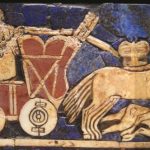 Music
Music  Music
Music  Space
Space 10 Asteroids That Sneaked Closer Than Our Satellites
 Sport
Sport The 10 Least Credible Superstars in Professional Sports
 Animals
Animals 10 Strange Times When Species Evolved Backward
 Facts
Facts Ten Unexpectedly Fascinating Facts About Rain
 Crime
Crime 10 Dark Details of Australia’s Gruesome Unsolved Wanda Murders
 Humans
Humans 10 Unsung Figures Behind Some of History’s Most Famous Journeys
 Animals
Animals 10 Species That Refused to Go Extinct
 Weird Stuff
Weird Stuff 10 Weird Things People Used to Do at New Year’s
 Our World
Our World 10 Archaeological Discoveries of 2025 That Refined History
 Music
Music 10 Chance Encounters That Formed Legendary Bands
 Space
Space 10 Asteroids That Sneaked Closer Than Our Satellites
 Sport
Sport The 10 Least Credible Superstars in Professional Sports
Who's Behind Listverse?

Jamie Frater
Head Editor
Jamie founded Listverse due to an insatiable desire to share fascinating, obscure, and bizarre facts. He has been a guest speaker on numerous national radio and television stations and is a five time published author.
More About Us Animals
Animals 10 Strange Times When Species Evolved Backward
 Facts
Facts Ten Unexpectedly Fascinating Facts About Rain
 Crime
Crime 10 Dark Details of Australia’s Gruesome Unsolved Wanda Murders
 Humans
Humans 10 Unsung Figures Behind Some of History’s Most Famous Journeys
 Animals
Animals 10 Species That Refused to Go Extinct
 Weird Stuff
Weird Stuff 10 Weird Things People Used to Do at New Year’s
 Our World
Our World 10 Archaeological Discoveries of 2025 That Refined History
10 Shocking and Gruesome Founding Father Facts They Don’t Teach in School
The Founding Fathers of the United States weren’t as perfect as we sometimes make them out to be in the history books. In fact, some had downright gross and gruesome secret aspects of their lives. Of course, that should make sense. They were human, after all. Just like other humans, they were imperfect and tempted by occasional urges and desires. But with all the worship of the Founding Fathers for what they did in creating and molding the United States, it’s difficult sometimes for us to see past the perfection and be honest about the flaws.
Well, let’s change that today! In this list, we’ll take a glance at ten very gruesome and shocking facts about America’s Founding Fathers. These are things that might leave you feeling a little bit unsettled. But they’re true! And they prove that the Founding Fathers weren’t above reproach. They may have created a great country, but even they had some serious skeletons in their closet. (In Ben Franklin’s case, you’ll soon read how we mean that last sentence literally.)
Related: Top 10 Brutal Realities Of The American Reconstruction
10 Washington’s Loophole
In 1780, the Commonwealth of Pennsylvania passed a law called the Gradual Abolition Act. It basically intended to slowly allow for enslaved people to be set free under various abolition rules. The law stated that any enslaved person who lived in Pennsylvania for more than six months could petition for their freedom.
However, some legal loopholes could be exploited by slave owners who weren’t interested in allowing their sources of free labor to walk off. Sadly, George Washington was one of those owners. He had owned slaves since the ripe young age of 10 while growing up in Virginia. By the time the Gradual Abolition Act of 1780 came into play, America’s first president was an expert at maneuvering through the loopholes.
He was living in Philadelphia then and would do something ingenious to keep his slaves under his thumb. Secretly, Washington would send his enslaved people out of the Pennsylvania state borders every six months to do work elsewhere before returning. That way, he constantly reset the clock on the slaves’ time in Pennsylvania.
Washington perfectly and cruelly exploited the six-month loophole by having his slaves leave the state, thereby sticking with him and not being allowed to become free after that six-month window. That’s pretty damn dastardly if you ask us.[1]
9 Do No Harm?
In the summer of 1793, a yellow fever epidemic swept through Philadelphia. There were about 45,000 people in Philly at the time, and the epidemic claimed the lives of roughly 5,000 of them. Those numbers were unheard of, and it was a truly horrific tragedy for Pennsylvania and the United States as a whole. Sadly, one of the signers of the Declaration of Independence likely made the yellow fever epidemic far worse than it could have been with his wholly ineffective cures.
That man was Dr. Benjamin Rush, who was by then one of the best medical practitioners in the state of Pennsylvania. He was also a hero and a patriot for his help in getting the United States off the ground. But what he did during the yellow fever epidemic of 1793 is still hotly debated to this very day.
Dr. Rush believed that purging the body through forced bloodletting and induced vomiting would cure people who were suffering from yellow fever. He brought in patients who were suffering from the disease, cut their veins open, forced them to vomit up the contents of their stomachs, and prayed that it would heal them of the awful disease. Of course, it didn’t.
Not only did he fail to cure any patients of yellow fever in that way, it depleted them of energy, thereby worsening their conditions. In the end, things got so bad that other doctors around Philadelphia began to demand that Rush stop treating patients.[2]
8 King Adams?
John Adams had a much rougher go of it as America’s second president than the history books would have you know. For one, he had to follow George Washington, who was by far the most beloved public figure at the time. But even beyond that, Adams was far less charming and personable. And even more concerningly, Adams desperately wanted to re-do the monarchy in America—with himself as the king.
While serving as the vice president under Washington, Adams began to insist that everybody call the President “His Majesty.” Worse yet, he even had a more official, longer title that he kept trying to get people to use: “His Highness, the President of the United States of America, and Protector of the Rights of the Same.” But nobody wanted that! Heck, they’d just fought off British rule and the monarchy for a reason!
Adams was unswayed, though. When he became president after Washington’s service ended, he took things even further. During his reign (er, uh, run) in office, Adams created some of the most unpopular legislation of all time. Chief among those creations were the Alien and Sedition Acts.
These acts made it illegal to criticize the government and its ruler (er, uh, its president). Obviously, Americans felt like they’d just escaped one monarchy and become free; they couldn’t possibly want to backslide into a second one. And especially not with somebody as unpopular and out of touch as John Adams running things![3]
7 Wife in the Basement
Patrick Henry was the Founding Father who so famously uttered the words, “Give me liberty or give me death.” But while he may have felt that way about the British, he certainly didn’t put that into practice in his real life. His wife, Sarah, was an ideal spouse during the early years they were married. But after she gave birth to her sixth child, she fell into a deep, unending depression.
Scholars today believe that she was probably suffering from an absolutely vicious case of postpartum depression. Back then, obviously, nobody knew what that was. And Patrick Henry simply couldn’t handle the fact that his wife was seemingly going insane right in front of his eyes rather than continuing to bear, care for, and raise their children. So he locked her in the basement.
As the legend goes, Sarah supposedly even went so far as to try to drown one of their children. Patrick couldn’t have that, so he shut her up in the basement and threw away the proverbial key. At the time, the Founding Fathers and many others considered mental illness to be a sign of evil. Few knew how to care for the mentally ill, and certainly not in a situation as serious as Sarah’s case.
Therefore, Patrick chose to keep her in the basement for years on end. He even had her fashioned with a primitive version of a straight jacket and made sure that she was under constant supervision around the clock. She lasted four years living like that until she eventually perished. Most experts today believe she took her own life.[4]
6 A Poisoned Patriot
Virginia judge and former attorney general George Wythe was one of the brightest legal minds to sign the Declaration of Independence. But at home, in the years after the Declaration was signed and the United States came into being, he had a persistent family issue that he just couldn’t shake. Wythe died in 1806 in Richmond after he was poisoned by his grand-nephew.
At issue was Wythe’s threat that he would cut his grand-nephew out of his will. The younger man didn’t want to be cut out so unceremoniously from such a potentially lucrative situation, so he threw a fit. Then, he tried to secretly poison Wythe—and amazingly, even though he was caught in the act by a slave, he succeeded!
Wythe and his 16-year-old protégé Michael Brown were enjoying coffee one day that had been poured by one of the enslaved people who worked under Wythe at his Richmond-area plantation. Suddenly, after drinking the coffee, all three of them started to suffer horrifying stomach pains. Brown and the enslaved victim were thankfully able to recover from the poisoning. Unfortunately, Wythe was not, and he died within days.
But here’s where the story really gets crazy. The enslaved person was a woman named Lydia Broadnax, and she told the authorities that she personally witnessed the grand-nephew throw some scrap of paper into the coffee pot before it was served. Seems like an open-and-shut case, right? Wrong! According to Virginia law at the time, Black people weren’t allowed to testify against white people in court. So, Wythe’s grand-nephew was ultimately acquitted of murder.[5]
5 Ben’s Bones
More than two centuries after Ben Franklin died, workers renovating his home in London when he lived in the United Kingdom uncovered more than 1,200 pieces of human bone on the premises. The year was 1998, and workers had been tasked with very carefully preserving Ben’s London home to honor the memory of the Founding Father of the then-fledgling United States.
However, they were shocked when they came across the thousand-plus pieces of bone from what experts now estimate to be about 15 different humans—including six children. Was Ben Franklin secretly a Jack The Ripper-type serial killer while he lived in London? Well… no. At least, probably not. We HOPE not.
What is far more likely is that Franklin was probably assisting an underground anatomy school in studying bones and dead people for science. See, back in the late 18th century, it was considered inappropriate and morally wrong to study dead bodies.
Franklin, like many other progressive thinkers, disputed that custom. He recognized that studying the human body could give us new insights into science and medicine. So, it’s likely he secretly carried along bodies from graveyards to anatomy schools for the purposes of better learning about the human form. Still wild! But not “serial killer” wild.[6]
4 Tortured for Freedom
The Founding Fathers risked a considerable amount to sign the Declaration of Independence. Doing so was to commit pretty serious treason against the British empire that had ruled over the colonies. The risks associated with sticking their neck out there were well-known by all the Founding Fathers.
However, none felt that more acutely than New Jersey signer and esteemed Continental Congress member Richard Stockton. After he signed the Declaration, a group of Redcoats set out to kill Stockton. Thankfully, he was able to whisk his family away to safety. But he personally wasn’t so lucky to escape.
The British invaded New Jersey after the document was signed, and one of their first acts was to go to Stockton’s home. They captured and imprisoned him at once. Then, for years following his signature appearing on the Declaration, he was brutally tortured in awful conditions at Provost Prison in New York. He was starved, forced to endure winter temperatures with barely any clothing, beaten, and assaulted. The acts of torture ruined Stockton’s health.
They were also so terrible that they eventually made him recant his pledge to be a patriot just so he could be released. When he was finally paroled and returned to his New Jersey estate, he found it had been completely ransacked. To add further insult to injury, Stockton’s library—which had been one of the foremost in the colonies at the time—was completely destroyed.[7]
3 No Rest for the Dead
Thomas Paine was one of America’s foremost thinkers by the time the new nation was born. There was nary a Founding Father who was more intelligent than Paine. And yet the end of his life didn’t go so well—not nearly as well as when he wrote the world-famous pamphlet “Common Sense,” at least.
Paine passed away in 1809 and was buried in a very modest grave with not even ten people around to attend his funeral. He was nearly financially insolvent at the end of his life, too. He’d publicly gone against the church and, in turn, lost popularity among many Americans. Sadly, he died mostly anonymously in that way. But it was what happened after his death that is truly unsettling.0
Ten years after Paine died, in 1819, a man named William Cobbett dug up his remains and planned to take them back to London for a more respectful burial. But fate intervened, and Cobbett never returned to London with Pain’s remains. Instead, the remains were passed down from generation to generation through Cobbett’s family members. In turn, they slowly sold off bits and pieces of Paine’s dead body, or whatever was left of it, through the years.
Decades and then centuries later, devotees of Paine have tried to give him a proper burial in New York. But they can’t find his entire body to do so! His head is supposedly in Australia, with other body parts flung all over the world. Talk about not exactly resting in peace…[8]
2 The Homeless Founding Father
The oldest signer of the Declaration of Independence was a simple farmer and mostly uneducated 65-year-old man named John Hart. Called “Honest John” by all who knew him, Hart was a family man and an easygoing, hardworking guy. He lived in New Jersey, farmed the land there, and was part of the formation of the new nation.
But more than any other Founding Father, he faced awful consequences for his decision to become a patriot. In 1776, his beloved wife of 36 years passed away. Then, within months of that tragedy, and just a few weeks after he signed the Declaration of Independence, the Redcoats moved in.
British forces swept onto Honest John’s farm in New Jersey and forced him and his 13 children out of their home. Horrified, Hart sent the youngest of his children to go live with the neighbors. The oldest ones tried as best they could to salvage their farm, but it was nearly impossible.
The British descended on the land, killed all of his cattle, rooted the property, destroyed the crops Hart had so painstakingly planted, and even partially destroyed his home. In turn, Honest John went to live in the hills—literally. As a very old, frail man, he lived in and hid around caves near his property. He successfully avoided the British, but it came at the cost of his home and his entire way of life.[9]
1 What a Way to Go…
Few Founding Fathers passed on into the next life as awfully as New York Senator Gouverneur Morris. He was one of the most legendary Founding Fathers of his time and is all but forgotten by too many people today. It wasn’t necessarily because he was such an incredible orator or politician, though. He was mostly remembered during his day for the insane predicaments in which he found himself.
In addition to writing up the first draft of the Preamble to the Constitution, Morris was a notorious womanizer who carried on affairs with many of high society’s most elite women in both the United States and Europe. He walked on a peg leg, too, which rumors at the time claimed he’d gotten after jumping out of the bedroom window of a married woman with whom he’d been having an affair to run from her husband.
That story about the peg leg wasn’t true, but the rumor solidified Morris’s reputation as a wild child nonetheless. In the end, in 1816, his wild days caught up with him in the worst way. Morris died at just 64 years old after trying and failing to cure a urinary tract blockage at home with some, uh, tools that he had lying around the house.
That’s right: he performed his own surgery on his penis… and failed. We can’t really imagine a more painful way to go. Or a more embarrassing one, to be honest. How come we never read about THAT in the history books?[10]








